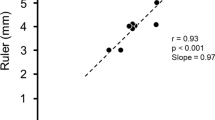Abstract
The diaphragm is the key muscle of respiration, especially in infants. Diaphragmatic dysfunction and paralysis can have significant implications for medical management and treatment, and they can be challenging to diagnose by clinical parameters alone. Multiple imaging modalities are useful for assessing the diaphragm, but US — specifically M-mode US — offers several distinct advantages and few limitations compared to fluoroscopy, radiography, CT and MRI. The purpose of this manuscript is to discuss the pathophysiology of the diaphragm, review common indications for dynamic diaphragmatic US, describe optimal imaging technique, and discuss how to avoid imaging pitfalls.







Similar content being viewed by others
References
Weber MD, Lim JKB, Glau C et al (2021) A narrative review of diaphragmatic ultrasound in pediatric critical care. Pediatr Pulmonol 56:2471–2483
Gil-Juanmiquel L, Gratacós M, Castilla-Fernández Y et al (2017) Bedside ultrasound for the diagnosis of abnormal diaphragmatic motion in children after heart surgery. Pediatr Crit Care Med 18:159–164
Sanchez de Toledo J, Munoz R, Landsittel D et al (2010) Diagnosis of abnormal diaphragm motion after cardiothoracic surgery: ultrasound performed by a cardiac intensivist vs. fluoroscopy. Congenit Heart Dis 5:565–572
Epelman M, Navarro OM, Daneman A, Miller SF (2005) M-mode sonography of diaphragmatic motion: description of technique and experience in 278 pediatric patients. Pediatr Radiol 35:661–667
Cox M, Soudack M, Podberesky DJ, Epelman M (2017) Pediatric chest ultrasound: a practical approach. Pediatr Radiol 47:1058–1068
IJland MM, Lemson J, van derHoeven JG, Heunks LMA (2020) The impact of critical illness on the expiratory muscles and the diaphragm assessed by ultrasound in mechanical ventilated children. Ann Intensive Care 10:115
Johnson RW, Ng KWP, Dietz AR et al (2018) Muscle atrophy in mechanically-ventilated critically ill children. PLoS One 13:e0207720
Glau CL, Conlon TW, Himebauch AS et al (2018) Progressive diaphragm atrophy in pediatric acute respiratory failure. Pediatr Crit Care Med 19:406–411
Banwell BL, Mildner RJ, Hassall AC et al (2003) Muscle weakness in critically ill children. Neurology 61:1779–1782
Mortamet G, Crulli B, Fauroux B, Emeriaud G (2020) Monitoring of respiratory muscle function in critically ill Children. Pediatr Crit Care Med 21:e282–e290
Levine S, Nguyen T, Taylor N et al (2008) Rapid disuse atrophy of diaphragm fibers in mechanically ventilated humans. N Engl J Med 358:1327–1335
Abdel Rahman DA, Saber S, El-Maghraby A (2020) Diaphragm and lung ultrausound indices in prediction of outcome of weaning from mechanical ventilation in pediatric intensive care unit. Indian J Pediatr 87:413–420
Xue Y, Zhang Z, Sheng CQ et al (2019) The predictive value of diaphragm ultrasound for weaning outcomes in critically ill children. BMC Pulm Med 19:270
Karmazyn B, Shold AJ, Delaney LR et al (2019) Ultrasound evaluation of right diaphragmatic eventration and hernia. Pediatr Radiol 49:1010–1017
Laing IA, Teele RL, Stark AR (1988) Diaphragmatic movement in newborn infants. J Pediatr 112:638–643
Verschakelen JA, Deschepper K, Jiang TX, Demedts M (1985) Diaphragmatic displacement measured by fluoroscopy and derived by Respitrace. J Appl Physiol 67:694–698
Chavhan GB, Babyn PS, Cohen RA, Langer JC (2010) Multimodality imaging of the pediatric diaphragm: anatomy and pathologic conditions. Radiographics 30:1797–1817
Toledo NS, Kodaira SK, Massarollo PC et al (2003) Right hemidiaphragmatic mobility: assessment with US measurement of craniocaudal displacement of left branches of portal vein. Radiology 228:389–394
Toledo NS, Kodaira SK, Massarollo PC et al (2006) Left hemidiaphragmatic mobility: assessment with ultrasonographic measurement of the craniocaudal displacement of the splenic hilum and the inferior pole of the spleen. J Ultrasound Med 25:41–49
Trinavarat P, Riccabona M (2014) Potential of ultrasound in the pediatric chest. Eur J Radiol 83:1507–1518
Urvoas E, Pariente D, Fausser C et al (1994) Diaphragmatic paralysis in children: diagnosis by TM-mode ultrasound. Pediatr Radiol 24:564–568
Boussuges A, Rives S, Finance J, Brégeon F (2020) Assessment of diaphragmatic function by ultrasonography: current approach and perspectives. World J Clin Cases 8:2408–2424
El-Halaby H, Abdel-Hady H, Alsawah G et al (2016) Sonographic evaluation of diaphragmatic excursion and thickness in healthy infants and children. J Ultrasound Med 35:167–175
Author information
Authors and Affiliations
Corresponding author
Ethics declarations
Conflicts of interest
None
Additional information
Publisher's note
Springer Nature remains neutral with regard to jurisdictional claims in published maps and institutional affiliations.
Supplementary Information
Below is the link to the electronic supplementary material.
Supplementary file1 (MP4 571 KB)
Online Supplementary Material 1 US in a 13-year-old boy with transverse myelitis and quadriplegia (same boy as in Fig. 3). A Real-time (videoclip) midline (ML) subxiphoid transverse gray-scale US image obtained while the boy was on ventilatory support shows poor motion of both hemidiaphragms. b Real-time (videoclip) midline (ML) subxiphoid transverse gray-scale US imaging obtained while the boy was off ventilatory support shows motion in the left upper quadrant consistent with the expected left diaphragmatic excursion, with absent motion of the right upper quadrant structures and right hemidiaphragm consistent with right diaphragmatic paralysis. The left diaphragmatic excursion appears exaggerated and measures 2.1 cm. Diaphragmatic excursion and paralysis are easier to appreciate off of ventilatory support
Supplementary file2 (MP4 953 KB)
Rights and permissions
About this article
Cite this article
May, L.A., Epelman, M. & Navarro, O.M. Ultrasound imaging of diaphragmatic motion. Pediatr Radiol 52, 2051–2061 (2022). https://doi.org/10.1007/s00247-022-05430-7
Received:
Revised:
Accepted:
Published:
Issue Date:
DOI: https://doi.org/10.1007/s00247-022-05430-7




